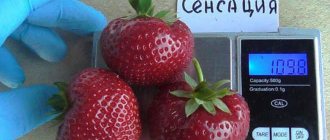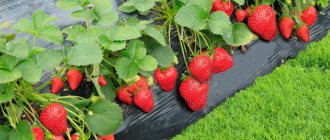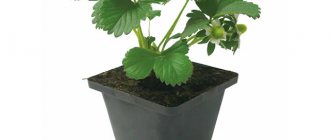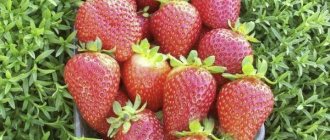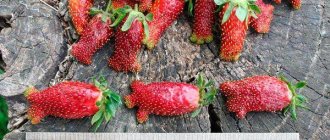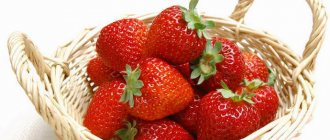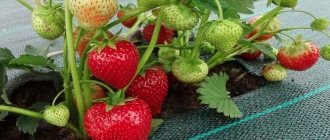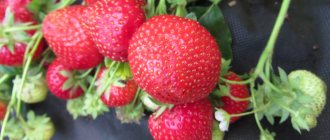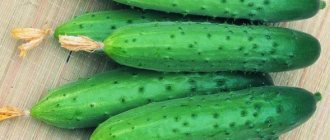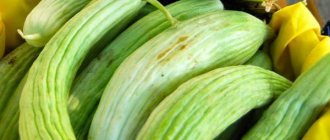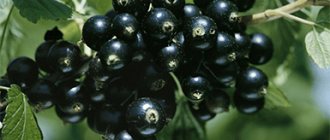Strawberries are the taste of childhood, a summer afternoon, a walk in the forest, from where they carefully carried a handful of cheerful and sweet berries. They started growing strawberries in the garden relatively recently, outdoors or in a greenhouse.
Strawberry bushes are also used to decorate gardens, parks, plots and even city apartments, creating amazing flower beds and garlands of strawberries. Choose remontant varieties that bloom and bear fruit twice a season.
Bushes
The bushes are spherical, small in size, grow up to 20-25. cm in height. They have medium foliage. The leaf blades are bright green, jagged, with a gray-blue tint.
The peculiarity of the ampelous variety is that the plant throws out the mustache before the peduncles. The rosettes that form on the tendrils bloom and bear fruit, even without rooting. From the outside, the plant looks like a garland strewn with berries and flowers.
Berries
The fruits are regular, slightly elongated, spherical in shape, bright red in color. Light seeds are deeply planted. The pulp is tender, juicy, very sweet, with a rich strawberry aroma. The average weight of the fruit is 30 g. For a remontant variety, this is a very good indicator. Experts rate the taste quality as 4 points out of five.
Productivity
From one bush you can collect more than 1 kg. berries On an industrial scale, farmers receive 600 centners per hectare. Fruiting continues continuously. On one plant you can see a flower, green and ripe berries.
To preserve the harvest, harvesting is done in the morning, after the dew has disappeared. The container must be well ventilated. If these conditions are met, strawberries can be transported over long distances. However, without refrigeration it will last no more than 3 days.
Strawberry Garland is ideal for fresh consumption. Large volumes are stored in the refrigerator (up to 10 days), frozen, and made into compotes and jams.
Pros and cons of the variety
Among the advantages of Strawberry Garland are:
- increased amount of harvest (up to 1 kilogram of berries can be collected from a bush in 1 season);
- long-term storage of fruits and ease of transportation (has medium density and does not crush during transportation);
- early onset of fruiting and late completion (before the onset of the first frost);
- taste and persistent strawberry smell (remontant varieties usually have a very weak taste);
- increased tolerance to most diseases;
- can be used as a decorative decoration for the garden;
- easy pollination - one plant per bed is enough;
- unpretentiousness of the variety to growing conditions.
Disadvantages of Garland strawberries:
- reduced resistance to drought;
- susceptibility to powdery mildew;
- susceptibility to fungal diseases with excessive levels of moisture in the soil.
a brief description of
Advantages of the variety
The variety is quite original due to its decorative effect and has a lot of advantages:
- long continuous fruiting;
- stable yield;
- ease of care;
- decorativeness;
- excellent taste and aroma;
- large fruit;
- possibility of transportation.
Regarding the remontant variety, this strawberry has only one drawback. It is necessary to ensure that the plantings are not thickened by extended tendrils and rosettes. Gardeners take this feature into account by immediately leaving an additional row for young seedlings when planting.
Advantages and disadvantages
Garland strawberries are popular in Russia. Gardeners choose it because of the following advantages:
- highly decorative, allowing the plant to be used to decorate a site;
- stable harvest throughout the season;
- no special requirements for content;
- good taste and intense strawberry aroma;
- sufficient density to allow transportation of the product.
This variety also has noticeable disadvantages. For example, increased cognitive ability. The summer resident must control the process and promptly prevent thickening of the center of the plant. Because of this, when planting “garlands,” it is recommended to maintain an interval so that young plants, after rooting, can form a new row.
Attention! Another drawback that complicates daily care is increased sensitivity to drying out or waterlogging. It is recommended to water the plant at intervals of 2-3 days, depending on the weather.
Landing
Planting dates depend on climatic conditions. In the south, where the spring is warm and dry, planting is planned in late March. In other regions, they focus on the time when return frosts recede. In autumn, you need to wait until the heat subsides and the weather is around +5 C. Planting in warmer conditions will lead to unwanted flowering.
In summer, the Garland should be planted and replanted on cloudy days and by shading the plantings from the sun's rays. The advantage of summer planting is that the bush has time to develop before winter and bears fruit well the next season. At first, all flower stalks of a fragile seedling should be removed.
To ensure that strawberries are protected from wind and drafts, they are placed near fences, buildings or fruit trees. Sometimes summer residents get out of the situation by planting corn or sunflowers along the strawberry bed.
Strawberries grow well after dill, parsley, garlic, onions, and carrots. After nightshades and pumpkins, there may be root rot infections. Raspberries should be planted as far away as possible to protect them from weevils.
Clay soil is improved with coarse sand or sawdust. If it is too sandy, it must be mixed with compost or manure when digging. The placement scheme may vary, the main thing is to give the bushes space. Standard placement provides a distance between plants of 30 cm, between rows of 70 cm.
Gardeners practice planting Garland strawberries in one row in the middle of a 1 meter wide bed. By mid-summer it is filled with fruiting tendrils.
How to choose strawberry seedlings when purchasing
It is best to buy garden strawberry seedlings from trusted nurseries that have many positive reviews and provide a guarantee for their product. You can purchase seedlings at different times of the year. If the purchase is made at the beginning of summer, then in August you can get the first harvest. Autumn purchase and planting is rarely done, since then the strawberry bushes will begin to bear fruit only after a year. It is best to buy Garland seedlings in early spring. In this case, you can get the first harvest by the beginning of the first month of summer.
Did you know? The largest strawberry in history weighed 231 g. It was plucked from a bush in Kent, USA, in 1983.
Garden strawberries are not resistant to various diseases. This should be taken into account when choosing seedlings, since some seedlings may already be infected, for example, with powdery mildew
When purchasing, it is necessary to evaluate the health of seedlings and pay attention to the following nuances:
- Spotting on the leaves indicates the presence of a fungal disease. It is better not to buy such seedlings in the spring, but at the end of summer, small small spots on the leaves are quite acceptable.
- Do not buy seedlings whose leaves are wrinkled. This indicates that the plants are damaged by a microscopic strawberry mite.
- It is strictly forbidden to buy seedlings with pale leaves. This symptom most likely indicates a dangerous disease - late blight necrosis.
VIDEO: HOW TO CHOOSE THE CORRECT STRAWBERRY SEEDLINGS
Below we present a number of signs that correspond to high-quality healthy strawberry seedlings:
- The leaves are green, heavily pubescent, without spotting or damage.
- The horn must be thick (at least 7 mm). The thicker the horn, the higher the productivity of the strawberry bush.
- The root system of seedlings in cups or cassettes should completely fill the soil volume.
- At least 3 leaves must be formed on the rosette.
- The roots must be healthy and free from damage and rot. Rot indicates the presence of a fungal disease.
READ ALSO: Tomato pink paradise f1: reviews, photos, characteristics of the bush, description, cultivation, video - greenhouse tips
Growing and care
Watering
In the absence of rain in summer, the plant is watered every 4 days with a water consumption of 2 liters per bush. Water getting on the leaves is undesirable.
Loosening, weed control
The next day after watering, the beds must be loosened to prevent compaction of the wet soil. Impaired air exchange leads to diseases of the root system.
Loosening is combined with weeding. Operations are carried out carefully so as not to damage the roots of the plant. Mulching the soil with sawdust and straw stops the growth of weeds and improves air exchange. From time to time the mulching mass is updated.
Removing a mustache
In the case of a hanging plant, by removing excess tendrils, a reasonable amount of them is achieved so that the plantings do not become thickened. The advantage of the variety is that the rosettes very quickly increase the vegetative mass and produce numerous flower stalks. Thanks to this feature, the yield increases several times. If there is not enough space in the garden bed, it is advisable to leave mainly first-order rosettes, which produce larger fruits.
Top dressing
Before flowering, it is advisable to feed strawberries twice with nitrogen fertilizers. This can be a solution of mullein (1:10) or bird droppings (1:20). A good fertilizer during this period is a 7-10-day infusion of nettle at a concentration of 1:20.
During flowering, the bushes are watered with a solution of potassium nitrate. A teaspoon of fertilizer is stirred in a bucket of water. One plant needs 0.5 liters. composition.
During fruiting, you can feed strawberries with an infusion of wood ash or yeast.
Pest and disease control
If you follow the agricultural cultivation techniques, the Garland will not get sick and no chemical treatments will be required. In damp, cold summers, snails may appear in the beds. Nettles spread around the perimeter of the area help. Garlic or marigolds planted between the bushes repel pests.
Preparing for winter
The Garland variety is winter-hardy. In cold regions, a mulching layer of dry humus is sufficient. Watering is stopped a month before the onset of persistent cold weather.
Before wintering, clear the beds of old leaves and loosen the soil to prevent pests from overwintering.
Agricultural technology for growing strawberries Garland
Growing Garland strawberries is practically no different from growing other varieties. You should choose sunny areas with loose fertile soil, without stagnant moisture. Seedlings should have a strong branched root system and an aerial part with 6-9 permanent leaves.
Good to know!
Almost any type of soil is suitable for cultivation (except for loams and very acidic soils).
Wood ash must be added to soil that is too acidic, river sand must be added to alumina when digging, and organic matter must be added to depleted soil.
In the southern regions, strawberry seedlings are planted in mid-April, and in more northern regions, planting dates may shift by 14-30 days.
Planting and further caring for Garland strawberries is practically no different from similar agrotechnical measures for other varieties of this berry crop.
The best time to plant strawberry seedlings - video
Reproduction
The variety is easily propagated by rosettes from the mustache and by dividing the bushes. It is possible to grow seedlings from seeds if it is impossible to obtain the required amount of ready-made planting material. Seeds are sown for seedlings in boxes in February. The photosensitivity of the seeds must be taken into account, so it is best to use peat tablets. From the moment of sowing to transplantation into open ground, approximately 120 days will pass.
On bushes intended for propagation by mustaches, the peduncles are removed. Place the resulting rosettes in separate pots. The first rosettes from the mother bush are considered the strongest.
It is advisable to divide two or three-year-old Garland bushes by the end of summer so that the young seedlings can take root before frost. The strongest and healthiest plants are selected for division.
Plant care
Seedlings need regular watering, fertilizing, loosening, treatment against insect pests and weeding.
Water the bushes as the soil dries, avoiding excess moisture. It is best to use the sprinkling method.
Organic fertilizers are applied to the soil once a month. Herbal infusions or mullein solution are used 2 times a month.
Reviews
I completely removed the variety from the site several years ago. Some Garland is demanding and capricious, but I didn’t feel any particular yield or taste. In my opinion, there are much more interesting varieties, for example, Syria or Alba. Of course, remontant varieties have their advantages, but for me taste and aroma come first.
Strawberry Garland has a reputation for being tenacious and not demanding to care for. By purchasing only 5-10 seedlings, you can already get a decent bed of strawberries in the first summer and enjoy the berries all summer long. Even without care, these strawberries feel great. But good yields can be achieved if you feed and water the bushes and take care of the plantings.
History of variety development
The Timiryazev Academy is famous for its breeding scientists, who have developed dozens of new varieties of fruit trees and shrubs, as well as other berry crops. This academy is also involved in developing new varieties of vegetables.
Professor of this academy Galina Fedorovna Govorova is the originator of many new productive varieties of strawberries and garden strawberries. The main thing this famous breeder focuses on is the resistance of plants to diseases and attacks by “harmful” bugs, as well as the ability to grow and bear fruit in regions of our country such as the middle zone, the Urals, Siberia and the Far East.
Strawberry garden garland - photo
The main positive quality of the Garland strawberry, bred by G. F. Govorova, is fruiting almost before the onset of frost. As long as the sun's rays illuminate the strawberry plantation, and the air temperature does not drop below +10+12C, this remontant variety is actively blooming and bearing fruit.
